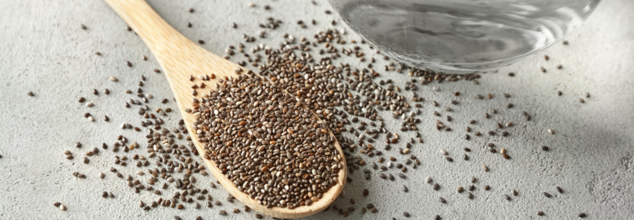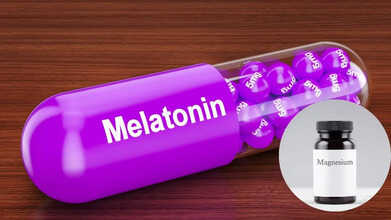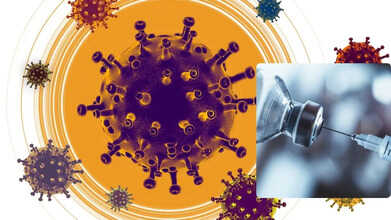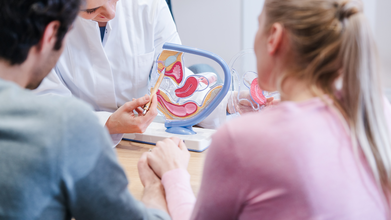- Health Conditions A-Z
- Health & Wellness
- Nutrition
- Fitness
- Health News
- Ayurveda
- Videos
- Medicine A-Z
- Parenting
- Web Stories
One Tablespoon Of These Seeds Can Be Your Sleeper Aids - Natural Sleep Booster You Should Have Everyday

(Credit-Canva)
Good sleep is one of the foundational traits of good health, and our activities, thoughts as well as what we eat, has an effect on it. What many people do not know is that certain foods have been associated with insomnia as well, for example alcohol can alter the circadian clock and worsen our sleep quality as well as spicy and hot foods have been associated with insomnia. So, what about foods that promote good sleep?
A doctor suggests a simple, natural solution: chia seeds. Dr. Alan Mandell, a chiropractor known as "Motivationaldoc" on social media, claims that just one tablespoon of this superfood before bed could help you fall asleep faster and wake up feeling completely refreshed.
Sleep-Boosting Power of Chia Seeds
According to Dr. Mandell, chia seeds are a powerhouse when it comes to improving sleep quality. Here's why:
Tryptophan for Sleep Hormones
Chia seeds have something called tryptophan. This helps your body make serotonin, which calms you, and melatonin, which tells your body it's time to sleep. This means you can fall asleep faster and stay asleep longer.
Magnesium for Relaxation
These tiny seeds are full of magnesium. This important mineral helps calm your nerves, reducing stress. If you're restless before bed, magnesium can help you get deeper, more restful sleep.
Omega-3s and Hydration
Chia seeds contain omega-3s, which can reduce inflammation, or swelling, that sometimes makes it hard to sleep. Also, when mixed with water, they form a gel that keeps you hydrated all night, stopping sleep problems caused by being thirsty.
Fiber for Satiety
The high amount of fiber in chia seeds makes you feel full. This can stop those late-night snack cravings that often interrupt your sleep.
Other Benefit of Chia Seeds
Beyond their sleep-enhancing properties, chia seeds offer a wealth of health advantages:
Nutrient-Dense: These little seeds are packed with good stuff! They're a great source of fiber, protein, healthy fats like omega-3s, calcium, phosphorus, magnesium, and antioxidants. They help your body work well.
Heart Health: The omega-3s and fiber in chia seeds are excellent for your heart. They help lower your blood pressure, bad cholesterol, and other fats, which significantly cuts down your risk of heart disease.
Blood Sugar Management: The impressive fiber in chia seeds helps keep your blood sugar levels steady. This is super helpful for people with diabetes, as it prevents big ups and downs in blood sugar.
Digestive Health: Because they're so high in fiber, chia seeds are wonderful for your gut. They help your digestion run smoothly, ensuring regular bowel movements and keeping your stomach comfortable.
Weight Management: The fiber in chia seeds also makes you feel full. This means you're less likely to overeat, which can really help you with your weight loss goals in a healthy way.
Complete Protein Source: Amazingly, chia seeds contain all nine essential amino acids your body needs. This makes them a complete protein, which is especially great if you're vegetarian or vegan.
Antioxidant Power: Chia seeds are rich in powerful antioxidants. These help protect your body's cells from damage, contributing to your long-term health.
Melatonin or Magnesium: Which One Actually Helps You Sleep Faster?

Credits: CANVA
Getting good-quality sleep does more than just help you wake up refreshed—it could also extend your lifespan. A 2023 study found that people who consistently fell asleep easily, stayed asleep through the night, and woke up feeling rested had a significantly lower risk of early death, and were 30% less likely to die from any cause, 21% less likely to have heart disease, 19% lower risk of cancer, and 40% lower risk from other causes.
Given these benefits, it’s no wonder many turn to supplements to improve their sleep. Two of the most popular options are melatonin and magnesium. But which one truly helps you drift into deep, peaceful sleep?
Role of Melatonin In Sleep
Melatonin is a hormone naturally produced by the body that helps signal it’s time to sleep,” says Kenneth Lee, M.D., medical director of the Sleep Disorders Center at UChicago Medicine. According to the Mayo Clinic, melatonin levels rise in the evening when it gets dark and drop in the morning with daylight. “It regulates your circadian rhythm, telling your body when to rest,” adds dietitian Stephanie Crabtree, M.S., R.D.
Melatonin production stays steady through young adulthood but begins to decline after age 40, according to the Cleveland Clinic. That’s one reason melatonin supplements are often studied for older adults. Dr. Lee notes that it can be especially helpful for issues like jet lag, shift work, or misaligned sleep schedules. “If you’re someone who can’t fall asleep until 1 a.m. but need to wake up early, melatonin taken at the right time can help shift your body clock,” he explains.
A 2022 review in Neuroscience & Biobehavioral Reviews found that melatonin helped people with sleep and neurodevelopmental disorders fall asleep faster and stay asleep longer. However, research is mixed for those using it as a general sleep aid. A Sleep Medicine Reviews analysis of 24 studies concluded that melatonin may help some people but is not consistently effective for all.
Side Effects of Melatonin
According to the Mayo Clinic, oral melatonin can sometimes cause headaches, dizziness, or nausea. Less common effects may include mild tremors, anxiety, or confusion. It can also interact with medications such as blood thinners, diabetes drugs, and contraceptives, so it’s important to consult your doctor before use.
How Magnesium Supports Better Sleep
Magnesium is a vital mineral involved in hundreds of body processes, including those linked to rest. “It helps calm the nervous system, relax muscles, and regulate neurotransmitters, which together promote sleep,” says Crabtree. It also supports the body’s natural production of melatonin.
Unlike melatonin, magnesium doesn’t directly trigger sleep but may improve relaxation and reduce nighttime restlessness. “It helps regulate GABA, a neurotransmitter that quiets the brain,” says Dr. Lee. A 2024 study in Sleep Medicine: X found that magnesium L-threonate supplementation improved sleep quality, though the results were based on self-reported data. “In my experience, some patients find magnesium helpful, while others notice little change,” Dr. Lee adds.
Side Effects of Magnesium
According to Dr. Lee, magnesium may cause nausea, diarrhea, or stomach cramps, especially at high doses. The NIH also notes that it can interfere with certain medications, including antibiotics, diuretics, and drugs for osteoporosis or acid reflux.
Melatonin vs. magnesium: Which Is Better?
Research remains inconclusive on which supplement works best. “Melatonin may help if your main issue is falling asleep, or if you’re adjusting to jet lag or shift changes,” says Crabtree. “But magnesium can be more effective for restless nights or tension that keeps you from relaxing. It also supports deep, restorative sleep and can be used safely for longer periods.”
Natural Ways To Sleep Better
Before turning to supplements, experts suggest improving your sleep habits. Dr. Lee recommends:- Practicing good sleep hygiene: Use your bed only for sleep and intimacy, avoid screens or heavy meals before bed, and create a calming pre-sleep routine.
- Trying cognitive behavioral therapy for insomnia (CBT-I): This structured approach helps retrain your mind and body for better sleep.
- Getting screened for sleep disorders: Persistent sleep problems may signal conditions like sleep apnea or restless legs syndrome, which require medical care.
Dietary supplements are meant to complement your diet, not replace medical treatment. They are not designed to diagnose, treat, or cure illnesses. Always consult a healthcare professional before starting any supplement, especially if you are pregnant, breastfeeding, or considering giving it to a child.
Is The ‘Frankenstein’ COVID Variant The Most Vaccine-Resistant Strain Yet?

Credits: CANVA
The Stratus strain, also known as the ‘Frankenstein’ variant, belongs to the SARS-CoV-2 XFG and XFG.3 lineages and has been spreading swiftly across the United Kingdom, with evidence suggesting it is also circulating globally. According to recent data from the UK Health Security Agency (UKHSA), these variants now account for nearly 30 percent of all COVID-19 cases in England, with XFG.3 emerging as the most dominant strain.
In recent weeks, medical experts have voiced concerns that the Stratus variant might have the ability to partially evade immunity built through vaccination, potentially increasing infection risks across all age groups.
What Sets the Stratus or ‘Frankenstein’ Variant Apart?
One of the unusual symptoms linked to this strain is a hoarse or raspy voice, which doctors say was rarely reported with previous variants. “Unlike earlier strains, Stratus carries specific mutations in its spike protein that may allow it to slip past antibodies formed through prior infection or vaccination,” explained Dr. Kaywaan Khan, a Harley Street general practitioner and founder of the Hannah London Clinic.
Is the Stratus Variant More Transmissible?
The XFG or Stratus strain is a member of the Omicron family and is a hybrid of two subvariants, LF.7 and LP.8.1.2. This combination of genetic material helps the virus attach more tightly to human cells, making it potentially more contagious. Like other variants, it also contains several mutations that may enhance its ability to evade antibodies produced either through infection or vaccination.
Could The ‘Frankenstein’ Variant Be The Most Vaccine-Resistant?
Early reports from health authorities suggest that existing COVID-19 vaccines still provide a degree of protection against the Stratus variant. Vaccines designed for earlier strains continue to reduce the risk of severe illness and hospitalization across multiple variants, and experts remain cautiously hopeful that they will do the same against Stratus. However, studies are ongoing to determine how much protection current vaccines actually provide against this specific strain.
As the situation develops, public health recommendations may change. Officials are urging people to follow reliable updates and continue to follow safety advice. Vaccination appointments remain widely available in the UK, and eligible individuals are encouraged to receive their doses or boosters as recommended.
What Are the Symptoms of Stratus?
The most common symptom so far appears to be a sore throat, though overall, the symptoms are similar to those caused by other COVID-19 variants. People infected with Stratus may experience:
- Fever
- Fatigue
- Cough
- Sneezing
- Runny or congested nose
- Nausea, vomiting, or diarrhea
So far, XFG has not been linked to more severe illness compared to previous variants, and hospitalization rates have not shown a sharp increase, which is reassuring.
Why The Stratus Variant Still Deserves Attention
Although it does not appear to cause more severe disease, the Stratus variant is a reminder that COVID-19 continues to evolve. Vaccines remain the strongest line of defense, and researchers are continuing to study how well they perform against this strain. Staying informed through credible sources and following updated health guidance can help limit the spread and keep communities safer.
3 Fertility Truths Every Woman Should Know, According To A Gynecologists

(Credit-Canva)
Infertility impacts millions across the globe, touching both men and women alike. According to the World Health Organization, around 17.5% of the global population, roughly one in six people, experience fertility challenges. This condition can significantly reduce or even prevent natural conception.
Yet, despite its prevalence, infertility remains clouded by myths and misconceptions, many of which unfairly place the blame solely on women. Seeking to debunk these long-held beliefs, Dr. Holly Miller, an American Board-certified obstetrician and gynecologist, took to Instagram to share three important truths every woman should know about fertility.
3 Truths About Fertility Women Should Know
With the help of modern medicine and medical interventions like IVF, fertility treatment can help people boost their chances of reproducing.
Infertility Isn't Just a Woman's Issue
It’s important to understand that infertility affects both partners — it’s not solely a woman’s issue. Blaming only the woman is both unfair and inaccurate. In fact, experts find that the causes of infertility are almost evenly split between men and women.
Roughly one-third of infertility cases are linked to the woman, another third to the man, and the remaining third result from issues affecting both partners — or from causes that doctors are unable to clearly identify.
To identify the cause of infertility, both partners should undergo testing simultaneously. For men, a semen analysis — a quick and straightforward test — is often the easiest and most informative first step.
The "Wait One Year" Rule Changes with Age
Most couples automatically try to conceive for a full 12 months before they think about seeing a fertility doctor. However, the doctor emphasizes that the woman's age is the single most important factor that affects the chances of successful treatment.
If you are under 35 years old: You can safely try for a full 12 months of regular, unprotected sex before seeking a specialist.
If you are 35 or older: You should contact a specialist after only 6 months of trying without success.
If you are 40 or older: You need to see a specialist right away—as quickly as you possibly can.
The doctor explains that after age 35, the woman's egg supply starts to decline more quickly. Time is essential, so couples should strongly ask their doctors for an early referral.
"Unexplained Infertility" Often Means "Undiagnosed Problem"
When a couple is diagnosed with "unexplained infertility," which happens in about 10% to 20% of cases, it means the basic first tests did not find a clear reason. This can be upsetting, but it does not mean you can never have children. In the doctor's experience, the term "unexplained" often means there are hidden problems, such as:
- Small issues with the male partner's sperm that were missed by the basic tests.
- A hidden condition called Endometriosis, which can only be confirmed by a surgical procedure.
- Not having sexual intercourse at the best time or not often enough.
© 2024 Bennett, Coleman & Company Limited

